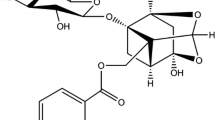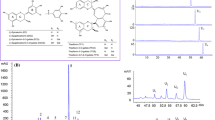Abstract
The binding of human serum albumin (HSA) with two food pigments, carmine and amaranth, were investigated at the molecular level using fluorescence, ultraviolet absorption and molecular docking techniques. Under simulated physiological conditions, the study proposes that the type of binding between the two dyes and HSA was static. Compared with carmine (293 K: KSV = (0.36 ± 0.02) × 105 L mol−1; Kb = (1.28 ± 1.21) × 107 L mol−1), amaranth (293 K: KSV = (1.62 ± 0.06) × 105 L mol−1; Kb = (4.07 ± 2.83) × 107 L mol−1) had a stronger quenching ability and higher affinity for HSA due to its more symmetrical stereochemical structure and less steric hindrance. From Förster’s nonradiative energy transfer theory (r < 7 nm, 0.5 R0 < r < 2.0 R0), it was inferred that energy transfer from HSA to the two dyes was highly probable. Spectral analysis (synchronous fluorescence, three-dimensional fluorescence and ultraviolet spectroscopy) showed that the binding of carmine or amaranth to HSA caused changes in the microenvironment around the Tyr and Trp residues and the secondary structure of HSA. A molecular docking simulation suggested that the two isomers bound to almost the same location of HSA, close to Sudlow’s site I, but there was a significant difference in the orientation of the two molecules. Combining the molecular docking and the thermodynamic parameters (Carmine: ΔH = − (50.03 ± 13.37) kJ mol−1, ΔS = − (52.01 ± 29.79) J mol−1 K−1; Amaranth: ΔH = − (72.23 ± 8.46) kJ mol−1, ΔS = − (109.75 ± 17.11) J mol−1 K−1), it can be inferred that hydrogen bonds and van der Waals forces play a dominant role in the formation of the dye–HSA complex.




Similar content being viewed by others
Abbreviations
- Eq.:
-
Equation
- HAS:
-
Human serum albumin
References
S. Kashanian, S.H. Zeidali, K. Omidfar, N. Shahabadi, Multi spectroscopic DNA interaction studies of sunset yellow food additive. Mol. Biol. Rep. 39, 10045–10051 (2012)
N. Pourreza, S. Rastegarzadeh, A. Larki, Determination of allura red in food samples after cloud point extraction using mixed micelles. Food Chem. 126, 1465–1469 (2011)
C. King-Thom, Mutagenicity and carcinogenicity of aromatic amines metabolically produced from azo dyes. J. Environ. Sci. Health C 18, 51–74 (2000)
W.E. Müller, U. Wollert, Human serum albumin as a ‘silent receptor’ for drugs and endogenous substances. Pharmacology 19, 59–67 (1979)
S.R. Feroz, S.B. Mohamad, N. Bujang, S.N.A. Malek, S. Tayyab, Multispectroscopic and molecular modeling approach to investigate the interaction of flavokawain B with human serum albumin. J. Agric. Food Chem. 60, 5899–5908 (2012)
K. Naveenraj, M.R. Raj, S. Anandan, Binding interaction between serum albumins and perylene-3, 4, 9, 10-tetracarboxyl ate-a spectroscopic investigation. Dyes Pigm. 94, 330–337 (2012)
G.W. Zhang, N. Zhao, L. Wang, Fluorescence spectrometric studies on the binding of puerarin to human serum albumin using warfarin, ibuprofen and digitoxin as site markers with the aid of chemometrics. J. Lumin. 131, 2716–2724 (2011)
L. Trynda-Lemiesz, Paclitaxel–HSA interaction binding sites on HSA molecule. Bioorg. Med. Chem. 12, 3269–3275 (2004)
J.N. Tian, Y.H. Xie, Y.C. Zhao, C.F. Li, S.L. Zhao, Spectroscopy characterization of the interaction between brevifolin carboxylic acid and bovine serum albumin. Luminescence 26, 296–304 (2011)
P. Bolel, N. Mahapatra, M. Halder, Optical spectroscopic exploration of binding of cochineal red A with two homologous serum albumins. J. Agric. Food Chem. 60, 3727–3734 (2012)
X. Zhou, X. Li, X.G. Chen, Binding mechanism of Orange G to human serum albumin: saturation transfer difference-NMR, spectroscopic and computational techniques. Dyes Pigm. 98, 212–220 (2013)
G.W. Zhang, N. Zhao, L. Wang, Probing the binding of vitexin to human serum albumin by multispectroscopic techniques. J. Lumin. 131, 880–887 (2011)
F. Pasban Ziyarat, A. Asoodeh, Z. Sharif Barfeh, M. Pirouzi, J. Chamani, Probing the interaction of lysozyme with ciprofloxacin in the presence of different-sized Ag nano particles by multispectroscopic techniques and isothermal titration calorimetry. J. Biomol. Struct. Dyn. 32, 613–629 (2014)
P. Bourassa, J. Bariyanga, H.A. Tajmir-Riahi, Binding sites of resveratrol, genistein, and curcumin with milk α- and β-caseins. J. Phys. Chem. B 117, 1287–1295 (2013)
Y.Q. Wang, H.M. Zhang, G.C. Zhang, W.H. Tao, Z.H. Fei, Z.T. Liu, Spectroscopic studies on the interaction between silicotungstic acid and bovine serum albumin. J. Pharm. Biomed. Anal. 43, 1869–1875 (2007)
X. Li, G. Wang, D. Chen, Y. Lu, beta-Carotene and astaxanthin with human and bovine serum albumins. Food Chem. 179, 213–221 (2015)
Y. Huang, Z. Zhang, D. Zhang, J. Lv, Flow-injection analysis chemiluminescence detection combined with microdialysis sampling for studying protein binding of drug. Talanta 53, 835–841 (2001)
J.R. Lakowicz, G. Weber, Quenching of fluorescence by oxygen. Probe for structural fluctuations in macromolecules. Biochemistry 12, 4161–4170 (1973)
Q. Dan, W. Xiong, H. Liang, D. Wu, F. Zhan, Y. Chen, Characteristic of interaction mechanism between β-lactoglobulin and nobiletin: a multi-spectroscopic, thermodynamics methods and docking study. Food Res. Int. 120, 255–263 (2019)
N. Bordenave, B.R. Hamaker, M.G. Ferruzzi, Nature and consequences of non-covalent interactions between flavonoids and macronutrients in foods. Food Funct. 5, 18–34 (2014)
J.H. Tang, F. Luan, X.G. Chen, Binding analysis of glycyeehetinic acid to human serum albumin: fluorescence spectroscopy, ftir, and molecular modeling. Med. Chem. 14, 3210–3217 (2006)
P.D. Ross, S. Subramanian, Thermodynamics of protein association aeactions: forces contributing to stability. Biochemistry 20, 3096–3102 (1981)
J.M. Wang, L. Ma, Y.H. Zhang, Investigation of the interaction of deltamethrin (DM) with human serum albumin by multi-spectroscopic method. J. Mol. Struct. 1129, 160–168 (2017)
Y.S. Chen, Y.F. Zhou, M. Chen, Isorenieratene interaction with human serum albumin: Multi-spectroscopic analyses and docking simulation. Food Chem. 258, 393–399 (2018)
G.F. Shen, T.T. Liu, Q. Wang, Spectroscopic and molecular docking studies of binding interaction of gefitinib, lapatinib and sunitinib with bovine serum albumin(BSA). J. Photochem. Photobiol. B 153, 380–390 (2015)
F. Ding, N. Li, B. Han, F. Liu, L. Zhang, Y. Sun, The binding of C.I. acid red 2 to human serum albumin: determination of binding mechanism and binding site using fluorescence spectroscopy. Dyes Pigm. 83, 249–257 (2009)
Y. Zhu, R. Zhang, Y. Wang, J. Ma, K. Li, Z. Li, Biophysical study on the interaction of an anesthetic, vecuronium bromide with human serum albumin using spectroscopic and calorimetric methods. J. Photochem. Photobiol. B 140, 381–389 (2014)
F. Hao, M. Jing, X. Zhao, R. Liu, Spectroscopy, calorimetry and molecular simulation studies on the interaction of catalase with copper ion. J. Photochem. Photobiol. B 143, 100–106 (2015)
F.S. Mohd, S.K. Mohd, M.H. Fohad, B. Bilqees, Deciphering the binding of carbendazim (fungicide) with human serum albumin: a multi-spectroscopic and molecular modelling studies. J. Biomol. Struct. Dyn. 37, 2230–2241 (2019)
T. Li, P. Hu, T. Dai, P. Li, X. Ye, J. Chen, C. Liu, Comparing the binding interaction between β-lactoglobulin and flavonoids with different structure by multi-spectroscopy analysis and molecular docking. Spectrochim. Acta A 201, 197–206 (2018)
Acknowledgements
The authors would like to extend their sincere appreciation to the Deanship of Henan science and technology research project (182102110286) and Key scientific research project of colleges and universities in Henan Province (18A550014). We thank Philip Creed, PhD, from Liwen Bianji (Edanz) (www.liwenbianji.cn/), for editing the language of a draft of this manuscript.
Author information
Authors and Affiliations
Contributions
Methodology, J-JC; project administration, JW; resources, J-HC; software, WL; supervision, JW; writing—original draft, JW.
Corresponding author
Ethics declarations
Conflict of interest
We declare that we have no financial and personal relationships with other people or organizations that can inappropriately influence our work, there is no professional or other personal interest of any nature or kind in any product, service and/or company that could be construed as influencing the position presented in, or the review of, the manuscript entitled “Characterization of the interactions of human serum albumin with carmine and amaranth using multi-spectroscopic techniques and molecular docking”. The authors declare no competing interests.
Additional information
Publisher's Note
Springer Nature remains neutral with regard to jurisdictional claims in published maps and institutional affiliations.
Rights and permissions
About this article
Cite this article
Wang, J., Cheng, Jj., Cheng, Jh. et al. Characterization of the interactions of human serum albumin with carmine and amaranth using multi-spectroscopic techniques and molecular docking. Food Measure 16, 4345–4354 (2022). https://doi.org/10.1007/s11694-022-01529-5
Received:
Accepted:
Published:
Issue Date:
DOI: https://doi.org/10.1007/s11694-022-01529-5




